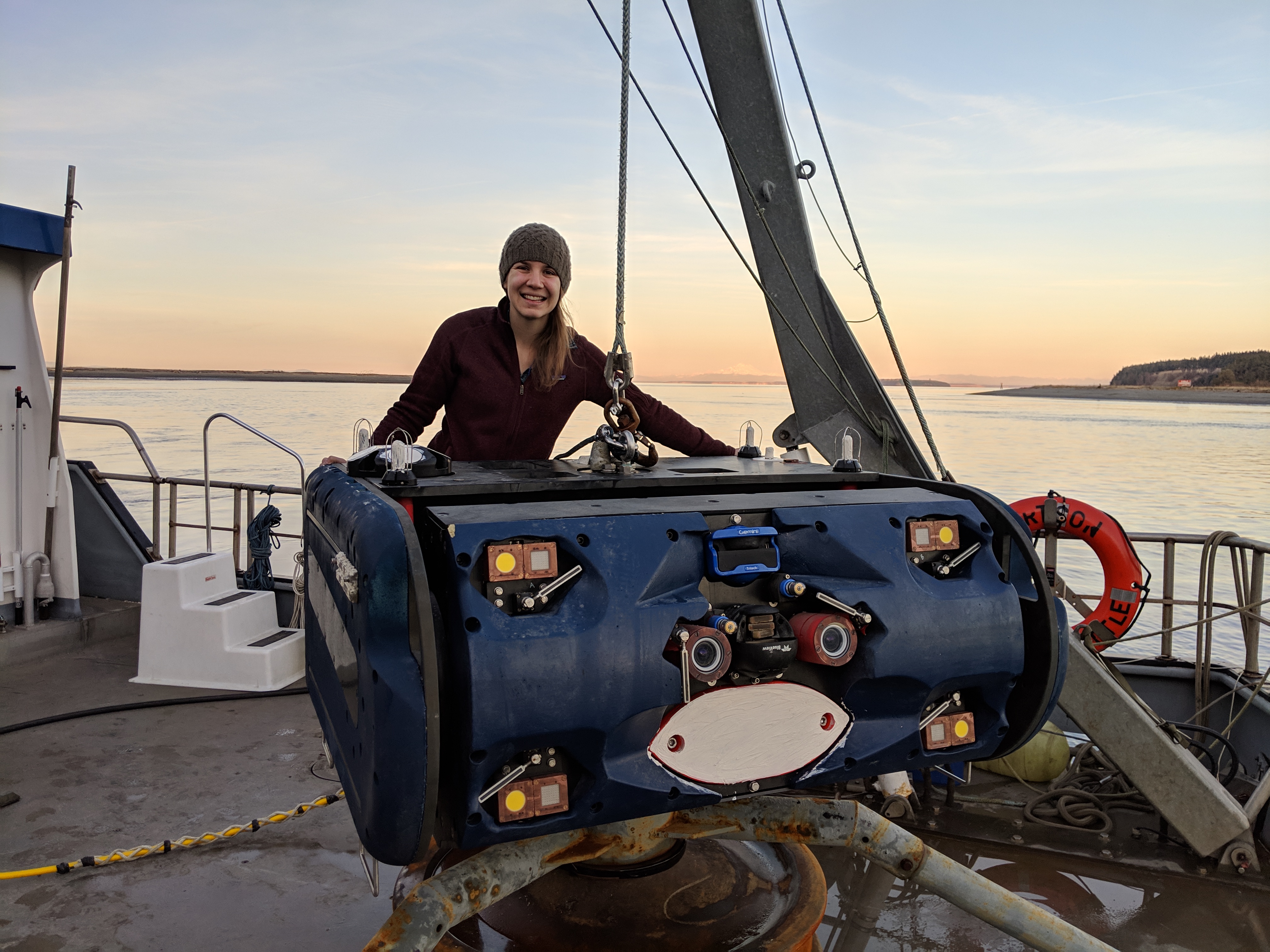Ocean Engineering for a Sustainable Future with Emma Cotter

Emma Cotter
(Photo courtesy of Emma Cotter)
Marine energy environmental monitoring research takes diverse teams of ecologists, biologists, oceanographers, data scientists, modelers, project managers, mechanical and electrical engineers, and many roles in between. Ocean engineering is one discipline that is integral to the advancement of the marine energy industry, including the development and deployment of monitoring technologies that help understand its environmental impact.
The Department of Energy Water Power Technologies Office's Triton Initiative is a project that aims to reduce barriers to testing marine energy devices by researching and developing scientifically defendable environmental monitoring technologies to understand potential effects to marine ecosystems. To make this research possible, ocean engineers work closely with marine and coastal scientists to understand and develop technical capabilities and applications of monitoring instruments. In the technical development phase, ocean engineers provide critical insights into things like how instruments acquire and transfer data and how they function in marine environments where they are subject to corrosion, weather, biofouling, and much more.
We want to introduce you to Triton Ocean Engineer and Scientist Emma Cotter, who has a long history of serving Triton projects—even before she joined the team.
Building a career from coast to coast
Cotter grew up near the sea in the state of Rhode Island. She always loved the outdoors and is drawn to contribute to climate change solutions. As someone with an affinity for mathematics, she knew from a young age that she could make a difference with numbers and was interested in renewable energy systems. In her undergraduate studies, Cotter pursued a degree in mechanical engineering. Through her college internships and talking to colleagues and mentors, she realized everyone doing the work she was most interested in had doctorate degrees. So, she pursued further education straight out of college. Cotter knew she wanted her research to focus on the environment and renewable energy. While she didn't intentionally pursue ocean applications at the time, her work kept leading her to salty waters.
Her PhD brought her west to the University of Washington (UW), where she worked on environmental monitoring technologies for marine energy applications for the Pacific Marine Energy Center. She was involved with several technology development projects in this research space, but most of her work focused on development of the UW Adaptable Monitoring Package. This experience provided the opportunity to work with big datasets and build her skills in machine learning. However, she was hungry to gain a more fundamental understanding of active acoustic sensors and how she could incorporate machine learning approaches. This led her back to the Atlantic Ocean, where she was a postdoc at Woods Hole Oceanographic Institution. At Woods Hole, she worked on the Ocean Twilight Zone project, which seeks to better understand the mesopelagic zone of the ocean (200 – 1000 m deep). During this 18-month fellowship, Cotter developed new approaches to analyze data from broadband echosounders and holographic cameras deployed in the deep ocean. After this fellowship, her love of renewable energy guided her back to the marine energy community, leading her to PNNL's Coastal Sciences Division as an ocean engineer in 2021. At Pacific Northwest National Laboratory (PNNL), she was initially hired to work for the Powering the Blue Economy Initiative but quickly plugged into other marine energy projects, including Triton.
The power of partnerships
Cotter's PhD work with UW is how she was introduced to PNNL. Her PhD work involved development of the Adaptable Monitoring Package (AMP)—an instrument package with multiple sensors that can monitor several aspects of the environment around marine energy systems in real-time. This project was funded by the Department of Energy and supported by the Triton team and facilities at PNNL-Sequim throughout the testing and development phase (read more about these projects here).
Sensors in the AMP include optical cameras, acoustic Doppler profilers, hydrophone arrays, imaging sonars, an echosounder, fish tag receivers, and more depending on the monitoring needs. These sensors work together to monitor, detect, and classify many aspects of the environment around marine energy systems, collecting real-time measurements. These measurements are used to assess environmental stressors associated with marine energy systems, such as underwater noise, collision risk, and changes in habitats. For this project, Cotter led the software development for the system, including data acquisition and control (read more about this research here). She also supported the initial field deployments of the AMP in Sequim Bay, where she worked with Triton and PNNL's research dive team to deploy the AMP for months at a time.
"I loved to be out in Sequim Bay doing this fieldwork," says Cotter, "a day in the field is always a better day than being behind a computer, even though things can be stressful." One notable thing about working in the field is that you must solve problems on the spot with the resources you have at hand; luckily, ocean engineers are well-equipped for these scenarios. "If you didn't pack the tool you need offshore, you have to improvise. This level of adaptation makes fieldwork exciting," Cotter adds.
Cotter supported several field deployments of the AMP in Sequim Bay and worked through many obstacles on the project’s path to success. With the help of Cotter, UW conducted multiple several-month deployments in Sequim Bay and worked with PNNL to test first, second, and third generations of the AMP. The technology has continued to evolve. It can be used in different environmental conditions and settings and integrated into marine energy devices where the energy harnessed by the device powers the sensor package. The AMP has been integrated with the Fred. Olson Lifesaver, deployed at the Hawaii Wave Energy Test Site, and an autonomous version of the instrument has been put to the test at PacWave. UW is currently working on multiple new versions and integrations. For example, the vessel AMP is being integrated into a research vessel at UW, which will be used as a tidal turbine testing platform to be deployed in various settings.

Triton helped support the AMP to the versatile monitoring package it is today. "Triton's support was critical for assessing the system's capabilities and making fixes along the way as we tested the system in Sequim Bay," says Cotter, "it's an example of a strong collaboration between two teams." Cotter will be involved with the AMP's next project, where the system is being integrated into the Oscilla Power Inc.'s Triton-C wave energy converter and will monitor a several-month demonstration at the Hawaii Wave Energy Test Site in the summer. Cotter now has a joint appointment with PNNL and the UW Department of Mechanical Engineering, allowing her to continue to be involved with this research and development and help facilitate future collaborations with UW. While the impetus of this joint appointment was to stay involved with the AMP project, she looks forward to using this opportunity to partner with UW on other Triton projects.
Engineering for Triton
Cotter now works on three Triton tasks, applying multiple aspects of her technical expertise to the program's newest research on stressor/receptor interactions. She currently supports the particle motion project led by Joe Haxel, which aims to understand how particles in acoustic waves impact the environment. In water, sound waves have two components: pressure and particle motion. To date, researchers have focused on the pressure amplitude of sound waves to quantify underwater noise effects on marine species. Recently, there has been increased attention to the particle motion component. Studies have shown that particular fish and invertebrate species may be more sensitive to particle motion than pressure. Few studies have measured particle motion in underwater environments, so the Triton team is working with industry partners to develop and deploy instrument packages that quantify particle motion alongside traditional hydrophone technologies for measuring the pressure component of underwater noise.
This research also addresses how to reduce flow noise that may contaminate underwater noise measurements or increased noise in the environment as water flows by a sensor. Flow noise is pseudo-sound (sound that does not propagate) caused by the flow of water past an acoustic sensor, similar to the sound you hear in your ear while riding a bicycle. Cotter leads an engineering team tasked with testing different shield strategies to minimize this unwanted noise. This work involves an in-depth literature review which has identified numerous methods for reducing flow noise; however, few studies discuss in-water and side-by-side comparisons. Cotter and her team will design flow shields and methods to perform a validation test in Sequim Bay this summer. She will lead the field deployment to quantitatively compare different shields for reducing the effects of flow noise.
Cotter also brings her experience working with multibeam sonars to Triton. She is working with Triton Fish Biologist Garrett Staines to investigate the capabilities and limitations of multibeam sonars for monitoring fish. The benefit of using multibeam systems is that they emit acoustic waves in a fan shape beneath the transceiver of the instrument. The amount of time it takes for the sound waves to reflect off an object and return to the receiver is then used to calculate distance. The multiple beams provide additional information about direction and movement, which means this technology can be used to characterize objects in the water column for collision risk studies. Through an in-depth review, Cotter and Staines hope to better understand how multibeam sonars have been used to monitor fish, including their limitations. This will inform future testing to develop best practices and new approaches for environmental monitoring. By understanding these systems' engineering principles, data outputs, and capabilities firsthand, Cotter offers a valuable perspective on how these technologies might help advance studies on environmental impact.
Lastly, Cotter is a co-task lead with another PNNL ocean engineer, Molly Grear, in Triton's Collision Control task. This task will advance a strategy for mitigating the collision of marine animals with tidal turbines by using algorithms to slow down turbines when marine mammals are present. This involves determining how pre-existing gauges can be used to detect if an animal is nearby. To test these control systems, Grear and Cotter’s team is developing three-dimensional models of marine mammals to test detection and control schemes in a flume. Flumes are constructed channels in laboratories where water can flow through in a controlled environment. In these studies, the flume will simulate a tidal channel and a tidal turbine prototype will be placed in its path. The animal models will then be moved through the channel to test how well the sensors on the turbine can detect the models and whether it is possible to slow the turbine blade speed in response. While this project is in its early phases, Grear and Cotter are planning laboratory flume tests at UW’s Harris Hydraulics Laboratory to be conducted next year. Cotter sees this as an exciting opportunity to use her joint appointment to bring together the great minds of Triton and UW to advance understanding of collision control solutions.
"I've always been excited about renewable energy, in general," says Cotter, "and there are a lot of advantages to marine energy. It doesn't have the same land use issues as other resources, and it provides unique solutions to power issues in a sustainable way." Cotter goes on to explain that "a lot of the work we are doing in Triton is supporting the sustainable development of an emerging industry. There are a lot of environmental concerns associated with marine energy. Without the tools to measure them, the industry can't move forward.” By helping answer these essential environmental questions in collaboration with other experts in the field, Triton's research can enable the industry to get more marine energy systems in the water and continue taking steps toward commercialization.

Written by Cailene Gunn.
Published: March 14, 2022